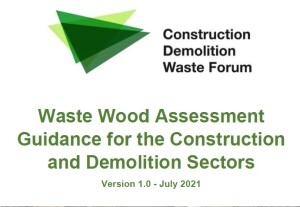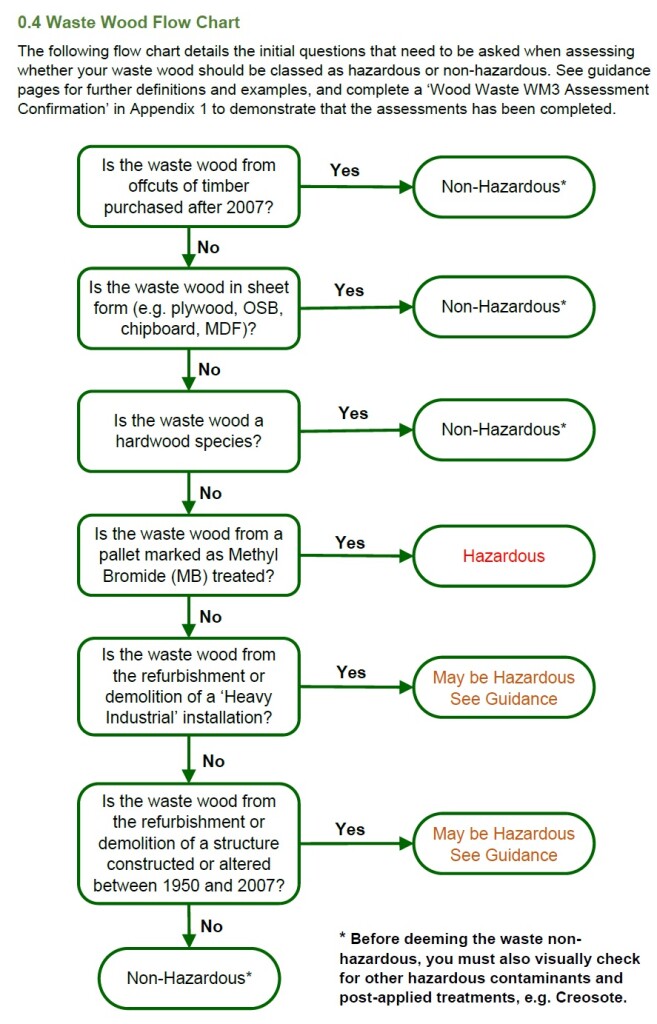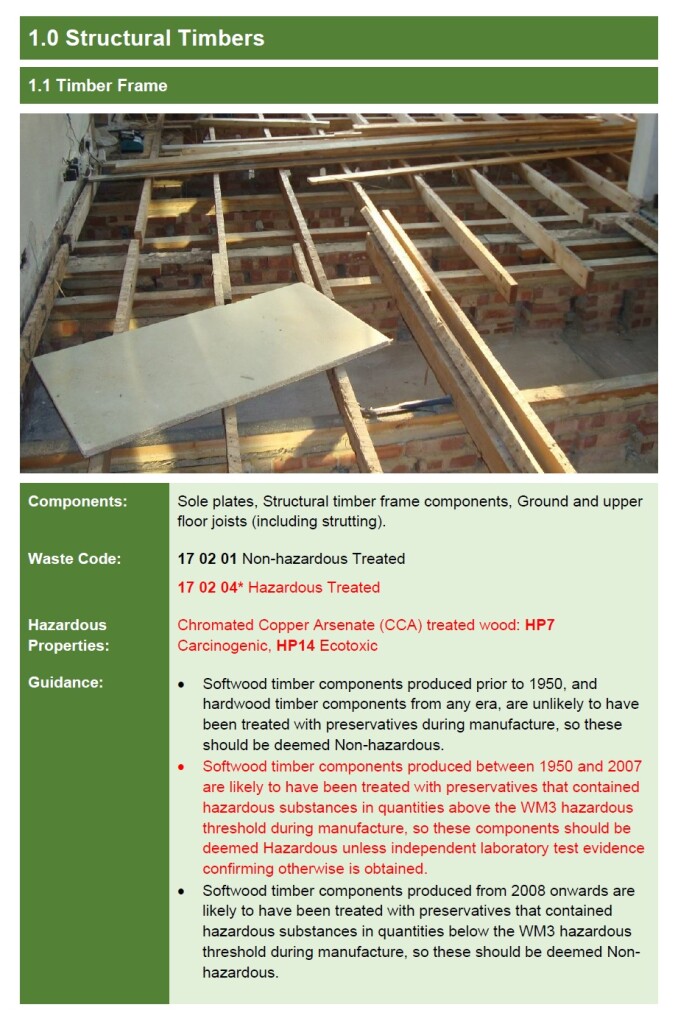New Guidance for Waste Wood Producers

Charlie Law September 2021 Waste
Introduction
New Waste Wood Guidance has recently been published by the CIWM Construction and Demolition Waste Forum, in conjunction with the National Federation of Demolition Contractors (NFDC) and the Wood Recyclers Association (WRA).
The new Waste Wood Assessment Guidance for the Construction and Demolition Sectors outlines the process to ensure waste wood from construction and demolition sites is properly classified at the time of disposal, and subsequently processed for appropriate end uses. It also helps identify which waste wood items are hazardous in accordance with Technical Guidance WM3. It is fully supported by the Environment Agency (EA).
The guidance includes a simple to use flow-chart and visual guides of various waste wood items that are likely to arise in the UK, and confirms whether they are classed as non-hazardous or hazardous. Timbers used for heavy industrial installations and certain softwood timbers (structural timbers, tile battens, external joinery, fence posts and decking) produced from 1950 through to 2007 are the main items of concern. These may have been treated with preservatives that contained hazardous substances in quantities above the current WM3 hazardous threshold, and originate only from demolition and refurbishment projects. This waste timber will need to be identified and segregated from other wood waste at source, and consigned as hazardous waste unless independent laboratory test evidence can be provided to confirm otherwise.
Background to the Waste Wood Classification Project
The WRA, CIWM C&D Waste Forum, and the NFDC have been working together on the Waste Wood Classification project since September 2017. This followed concerns that were raised early in 2017 about the potential for mis-describing waste wood and confusion about which waste wood items were hazardous. The WRA were approached by the EA to lead a project on behalf of the wider waste wood industry to ensure that:
- Waste wood is properly classified at its origin
- Waste wood is not mis-described and is processed into appropriate end uses
- There is a clear understanding of which items of waste wood are hazardous
SusConSol were subsequently approached by the NFDC to project manage their involvement in the project due to their knowledge of the timber industry.
A desk study, carried out by the Wood Protection Association (WPA), calculated the biocidal load within various treated timber components, based on a worst-case scenario for various treatment formulations used over the years from when they were first put on the market in the 1950’s. This confirmed that all timber items purchased after 2007, and timber from building constructed prior to 1950, were non-hazardous, as long as these timbers had not had any subsequent treatments applied (e.g. creosote). However, it did identify a number of timber components, including structural timbers, tile battens, external joinery, fence posts and decking, from buildings constructed prior between 1950 and 2007 were ‘potentially’ hazardous, as well as confirming that a number of timber components such as telegraph poles and railway sleepers should continue to be deemed hazardous.
A detailed sampling and testing plan was agreed with the EA in 2018 to test a small number of each ‘potentially’ hazardous component, to confirm the desk study results. However, it soon became clear that many of the samples that the desk study had identified as likely to be hazardous, actually returned a non-hazardous result. It was therefore decided to expand the sampling and testing plan to include a larger number of samples, and the testing continued throughout 2019 and into 2020.
In total 193 samples of decking and fence posts were tested by the WRA from material obtained from household sources, and 92 samples of structural timbers, tiling battens and external joinery were tested by the NFDC from material obtained from demolition sites of pre-2007 buildings.
The laboratory testing of the wood showed that the vast majority of the potentially hazardous timber components were non-hazardous. However, there was not enough evidence to confirm that all demolition and refurbishment timber from the demolition of pre-2007 buildings was non-hazardous, therefore these will continue to be tested on a project-by-project basis until such time as enough evidence is amassed.
Waste Wood Assessment Guidance Requirements
The Waste Wood Assessment Guidance for the Construction and Demolition Sectors was developed based on the results from the WPA desk study and the subsequent testing carried out by the WRA and NFDC. It includes a number of tools to help the user identify whether their waste wood should be dealt with as non-hazardous or hazardous waste in accordance with the WM3 Guidance. The first of these is the flow chart below:

Where it is identified from following this flow chart that none of the timber being disposed of is hazardous, no further assessment needs to be carried out. The user can complete the ‘Waste Wood WM3 Assessment Confirmation’ in Appendix 1 and send this to their waste management providers.
However, where it is identified that some timber components are potentially hazardous, additional actions need to be taken. The user should look at each of the components they are removing from the existing structure and refer to the relevant sections in the guidance to determine whether these timber components are deemed hazardous or non-hazardous. A list of confirmed non-hazardous components and potentially hazardous components should be compiled.

Confirmed non-hazardous components can be disposed of as non-hazardous waste, as long as a completed ‘Waste Wood WM3 Assessment Confirmation’ accompanies the Waste Transfer Note (WTN).
Timber components deemed hazardous should be tested to confirm whether the concentrations of hazardous treatments contained in the timber are above the WM3 threshold levels. Details of the tests to be carried out are contained within the guidance. Where the test results confirm the timber component as non-hazardous, the waste can be disposed of as non-hazardous waste, as long as a completed ‘Waste Wood WM3 Assessment Confirmation’ and the non-hazardous test evidence accompanies the WTN. However, where the test results confirm the timber component as hazardous, or if no testing is carried out, the components must be segregated from other wood waste at source, and disposed of as hazardous waste.
Any test evidence obtained confirming both hazardous and non-hazardous results, should also be sent to the NFDC to compile a more complete picture of the amount of hazardous timber still in structures.
New Regulatory Position Statements
The EA have issued two new regulatory position statements, one to cover waste wood from domestic premises disposed of at household waste recycling centres, and the other to cover the processing of waste wood from construction and demolition sites.
RPS 249 allows potentially hazardous waste wood received at household waste recycling centres (HWRCs) to move as un-assessed, non-hazardous material as long as it is destined for Industrial Emissions Directive (IED) Chapter IV compliant biomass or the manufacture of panel board. This RPS will remain in place until the end of March 2024 to give the waste wood industry time to demonstrate that there is no longer any hazardous content in household waste wood.
RPS 250 covers hazardous waste wood from demolition and refurbishment activities. This now requires all waste wood from construction and demolition sites to be assessed, and where deemed hazardous, consigned as hazardous waste using a hazardous waste consignment note with the correct waste codes. However, it also allows for the collection, storage, processing and blending of potentially hazardous waste wood from domestic premises, demolition sites and other business premises, to be carried out under existing environmental permits.
Howard Leberman, Team Leader for the national leads on Non-Hazardous Waste, Biowaste, Waste Exemptions and Fire Prevention at the EA, said: “We have worked very closely with the WRA and their partners on this project and I am grateful to all the sector organisations that have played a part for their commitment to this undertaking.
“As environmental regulators we have a duty to ensure that industry is operating within safe boundaries and we are happy with the outcome of this project and believe that the guidance documents and the two Regulatory Position Statements will ensure that all waste wood is correctly classified going forward and will therefore be destined for the appropriate end use.”
If you would like us to help you move towards a more circular business model, please Contact us>
